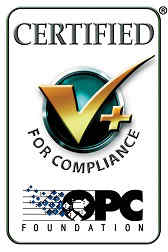QuickOPC for OPC-UA
(OPC Unified Architecture)
Are you having difficulties incorporating the OPC Unified Architecture (also known as OPC-UA, or IEC 62541) data into your solution? Need to create an OPC client supporting OPC-UA quickly and in quality? If so, QuickOPC comes to the rescue.
QuickOPC is a set of components that simplify the task of integrating OPC client functionality into applications. Reading a value from OPC Unified Architecture server, or writing a data value can be achieved in just one or two lines of code.
QuickOPC is a radically new approach to access OPC-UA data. Traditionally, OPC programming required complicated code, even with use of OPC Foundation SDKs. OPC server endpoints must be discovered, connections to OPC Servers must be instantiated, OPC Subscriptions must be created and manipulated, and OPC Monitored Items must be added and managed properly. Too many lines of error-prone code must be written to achieve a simple goal – reading or writing a value, or subscribing to value changes.
The OPC UA client development components can be used from various languages and environments. The available examples show how the components can be used from C#, Visual Basic.NET, PowerShell, managed and native C++, VB 6.0, VBA (Excel), VBScript, Delphi (Object Pascal), Python, Perl, PHP and more. Windows Forms, ASP.NET pages, Windows services, console applications, and WPF applications are all supported. The development tool we have targeted primarily is Visual Studio.
Key Features
- Tested for compliance with OPC protocol standards, and for interoperability.
- Integration with Visual Studio development environment.
- Internal messaging layer provides isolation between OPC communications and the custom client code, resulting in high resiliency.
- Automatically connects to and disconnects from OPC Servers.
- No limits to number of connections, subscriptions, or tags.
- Supports all flavors of OPC synchronous and asynchronous reads and writes internally, subscriptions, discovery, browsing, and property access.
- Wide range of developer productivity features: Intellisense, ReSharper annotations, serialization support, and many more.
- Browsing Dialogs: Ready-made set of rich user interface (UI) components for browsing the OPC world.
Useful links: Documentation / Examples / Knowledge Base
Compatibility
 OPC Foundation Certified for Compliance logo indicates that this product has been tested by an independent certification lab and certified to be compliant with the following Certified OPC Profiles:
OPC Foundation Certified for Compliance logo indicates that this product has been tested by an independent certification lab and certified to be compliant with the following Certified OPC Profiles:
- Core Client Facet
- Base Client Behaviour Facet
- Discovery Client Facet
- Attribute Read Client Facet
- Attribute Write Client Facet
- Datachange Subscriber Client Facet
- DataAccess Client Facet
Many more profiles are supported - see OPC UA Profiles in the documentation for the full list, if you need to match the client capabilities against requirements expressed in terms of OPC UA profiles.
You can also consult lists of OPC UA Services and OPC UA Security Policies supported.
Additional information about compliance testing, logo program and a summary of test results can be found at www.opcfoundation.org for: QuickOPC.
OPC-UA Functionality Areas
With QuickOPC, following major functionality areas of OPC Unified Architecture are available:- Generic/Data (needed by most developers).
- Alarms & Conditions.
Footnote & required disclosure: QuickOPC (including its Options) is a software development kit (SDK) for development of OPC clients and subscribers. Installing QuickOPC or its Options does not change system settings.


